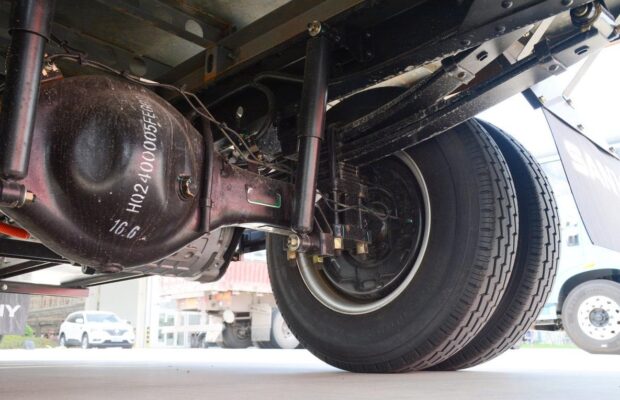Цахилгаан ачааны машины талаархи мэдлэг
Daily Precautions for Safe Lifting of Dump Trucks
In order to achieve the best performance of the cylinder and ensure the safety of the хогийн машин, the following хогийн машин lifting operation specifications must be followed during the use of the хогийн машин.
1. The front-top lifting dump cylinder can only be used as a lifting device and must not be used as a supporting structural component. Using the cylinder as a support structure can lead to excessive stress and potential damage. This is because the cylinder is designed specifically for the lifting action and may not have the strength and stability to withstand continuous static loads.

2. When in the lifting state, the cylinder should not be exposed to moist air for more than 30 хоёр хоног. Prolonged exposure to moist conditions can cause rust and corrosion on the surface of the cylinder, reducing its lifespan and functionality. Moisture can also seep into the seals and internal components, causing damage and potential leaks.
3. After the compartment is completely lowered, keep the air control valve handle in the “lowering” position for about 30 seconds. This helps to ensure that any remaining pressure in the system is released, reducing the stress on the components and preventing premature wear. It also allows the hydraulic fluid to return to the reservoir properly.
4. The хогийн машин lifting operation specification must not use sudden braking for unloading, otherwise it will seriously damage the vehicle, hydraulic cylinder or other hydraulic components. Sudden braking during unloading can create shock loads that exceed the design limits of the components. This can lead to bent or cracked parts, damaged seals, and even failure of the entire lifting system.
5. Do not use reverse gear when unloading. Reverse rotation of the power take-off and oil pump can easily cause damage to the oil pump and oil seal. The reverse rotation can cause improper lubrication and excessive stress on these components, resulting in premature failure and leaks. It can also disrupt the normal operation of the hydraulic system and potentially cause safety hazards.
6. Excessive engine speed will cause insufficient oil supply and damage to the hydraulic pump and cylinder. High engine speeds can cause the pump to operate faster than it is designed for, resulting in inadequate oil flow and pressure. This can lead to overheating, cavitation, and damage to the internal components of the pump and cylinder.

7. When the hydraulic system should be deactivated according to the хогийн машин lifting operation specification, separate the power take-off. Failing to do so can cause the hydraulic system to remain engaged, leading to unnecessary wear and potential damage. It can also drain the battery and cause other electrical issues.
8. Do not lift the cylinder when the compartment is unevenly loaded or in other abnormal situations. Uneven loading can cause imbalanced forces on the cylinder and the vehicle structure, increasing the risk of component failure and instability. Abnormal situations such as damaged or malfunctioning parts should be addressed before attempting to lift the compartment.
9. Do not lower the compartment during the process of lifting a heavy-load compartment. This can cause sudden changes in forces and stress, potentially damaging the cylinder, the lifting mechanism, and even the vehicle frame. It can also lead to the loss of control of the load, posing a serious safety threat.
10. Do not drive the vehicle when the air control valve handle is in the “lowering” position. Driving with the valve in this position can result in loss of control over the vehicle’s movement and the lifting system, increasing the risk of accidents and damage to the vehicle and its components.
Let’s consider a real-life example where a хогийн машин operator ignored the caution about not using sudden braking for unloading. During one operation, in an attempt to stop the unloading quickly, the driver applied a sudden hard brake. The shock from the sudden stop caused severe stress on the hydraulic cylinder and the lifting mechanism. Үр дүнд нь, the cylinder developed a leak, and the lifting system malfunctioned. This not only led to costly repairs but also caused significant downtime for the vehicle.
Одоо, imagine a scenario where the operator failed to keep the air control valve handle in the “lowering” position for the recommended 30 seconds after lowering the compartment. Цаг хугацаа өнгөрөх тусам, this led to residual pressure building up in the system, causing premature wear on the seals and valves of the hydraulic system. Эцсийн эцэст, this resulted in hydraulic fluid leaks and reduced the overall performance and reliability of the lifting system.
In another instance, if the engine speed was kept too high during the lifting operation, it could cause the hydraulic pump to overheat and fail prematurely. This would require replacing the pump, incurring additional costs and downtime.
Ирээдүйд, as technology in хогийн машин systems continues to advance, we may see more intelligent monitoring and control systems that enforce these safety precautions automatically. Жишээ нь, sensors could detect if the vehicle is in an incorrect gear during unloading or if the engine speed is too high and send alerts or even automatically limit the operation to prevent damage.

Түүнээс гадна, training and education for хогийн машин operators will become even more critical to ensure they understand and follow these safety guidelines precisely. Regular refresher courses and updated training materials can help keep operators informed of the latest best practices and safety standards.
Дүгнэж хэлэхэд, adhering strictly to the daily precautions for safe lifting of хогийн машинs is not only essential for the longevity and proper functioning of the vehicle but also for the safety of the operators and those around the vehicle. By following these guidelines and being vigilant in their application, potential problems and accidents can be avoided, and the efficiency and reliability of the хогийн машин operations can be maximized.
Жишээ нь, a construction company that enforces strict compliance with these safety precautions among its хогийн машин operators may experience fewer breakdowns, lower maintenance costs, and a better safety record. This can lead to improved project timelines and a better reputation in the industry.
Another example could be a fleet owner who invests in advanced training for their operators and installs monitoring systems in the vehicles. This proactive approach can result in fewer accidents, increased productivity, and potentially lower insurance premiums.
Товчхондоо, the importance of following these safety precautions cannot be overstated, and it is the responsibility of both the operators and the companies that own and manage the хогийн машинs to ensure they are followed at all times.